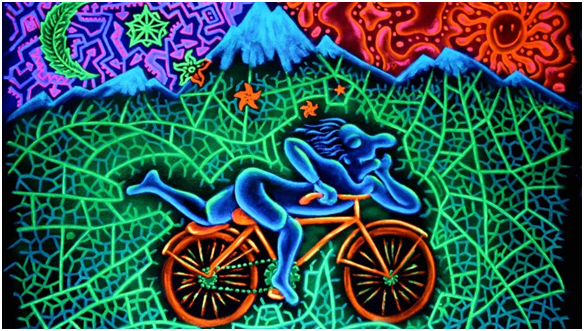Let’s Talk About LSD
Hop on your bike and join us for an exciting journey into the world of neurophysiology and hallucinations. I’m Stalinlingus, and I don’t recommend diving straight into the world of psychedelics. This article is positive and informative, but it’s not a call to start consuming LSD and mushrooms en masse. We want to warn you: using these substances is not safe, especially in Russia. Please take care of your mental and physical health, as well as your freedom.
The Discovery of LSD
On April 16, 1943, Swiss chemist Albert Hofmann accidentally discovered the effects of lysergic acid on the human body. While working in the lab without gloves, Hofmann carelessly allowed the substance to be absorbed through his fingertips, soon experiencing an incredible range of sensations that made him take a closer look at LSD. On April 19, he intentionally took 250 micrograms of the substance to study its effects in detail and create a real trip report. “Bicycle Day” is a symbolic holiday that reminds humanity of Hofmann’s amazing discovery.
Since then, other scientists have studied LSD, but the psychedelic was banned because it was often used recreationally. However, laws can’t stop people’s thirst for knowledge, so research into how lysergic acid interacts with the body continues to this day, albeit with more caution. Despite the enthusiasm of researchers, LSD is still not well understood, and we can’t make definitive conclusions about its harm or benefits for the human body. As a result, the topic remains highly controversial.
LSD’s Potential as a Therapeutic Tool for Mental Disorders
Mental disorders such as depression, post-traumatic stress disorder (PTSD), and various psychological addictions are based on pathological patterns of thinking that are nearly impossible to break. Recent studies of psychoactive substances like LSD, MDMA, and psilocybin have shown that these substances can weaken the synchronization between closely connected brain regions, which leads to the formation of pathological thought patterns. Psychedelics reduce blood flow to these areas, thereby disrupting their persistent synchronization. As a result, the pathological pattern becomes unstable and gradually breaks down. Moreover, moderate desynchronization of certain neural centers makes unlimited cognition possible.
LSD and Synesthesia
The hallucinogenic effects of LSD are due to the substance stimulating serotonin receptors in the brain. High levels of this neurotransmitter increase the excitability and connectivity of brain regions responsible for sensory perception. As a result, different regions of the brain respond to sensory input, making it possible for a person to “hear” colors or “see” sounds. LSD activates many areas of the brain that are usually inactive in a normal state, as shown in MRI studies.
Brain activity under placebo and LSD
LSD Reduces Suicidality and Severe Psychological Distress
A study by American scientists published last year concluded that psychedelics can be an effective therapy for depression and anxiety disorders, and may also help reduce the risk of suicide among adults. In an experiment involving more than 190,000 participants, significant improvements in overall psychological well-being were observed with LSD use, and the frequency of suicidal thoughts or attempts dropped significantly over the five-year study period.
LSD Is Not Addictive
Neither in large nor small doses does LSD cause addiction, unlike many other drugs, including legal ones like alcohol or tobacco. The reason is that LSD does not trigger dopamine release or activate the brain’s reward system, which reinforces certain behavioral patterns through psychological rewards. Drugs that activate the mesolimbic dopamine system are the ones that cause addiction, but LSD does not affect this system.
LSD Effects Are Noticeable Even at Microdoses
Taking just 20–30 micrograms of the substance (a microgram is 1/1000 of a milligram) already produces pronounced effects. Today, many people use even smaller amounts of LSD (10–15 micrograms) to combat social media addiction, insomnia, and anxiety. Foreign publications report that a little lysergic acid with breakfast can boost energy and productivity without causing hallucinations or trips. Silicon Valley IT professionals use the drug in microdoses to enhance creativity. Thus, LSD’s effects on the body are noticeable even at the smallest doses.
Stalinlingus



